What threatens the survival of Whale Sharks?
Fisheries
- In one fishery in India, as many as 1000 whale sharks were believed to be killed in 1999 and 2000. Their habit of swimming at the surface makes the whale shark easy to catch. Previously, the fins of whale sharks were sold for high prices on the Asian market, but demand for whale shark fins has declined. There is still a market for whale shark meat in several countries including Taiwan and China.
- In Taiwan, there is a quota of 120 whale sharks for capture per year, although this may be unsustainable. Of great concern is the reduction in size (length) of individuals caught in the Taiwanese fishery today compared with the early 1980s.
|
|
Natural predators
- There are very few known predators of the whale shark. In nature, the most dangerous period in their life cycle appears to be when the sharks are very young. The skin of an adult whale shark provides their main protection. The thickness of the skin on the dorsal surface of adult whale sharks is 12–15 cm (thicker than any other living animal), but in young whale sharks this ‘protection’ is not fully developed.
- Very few juvenile whale sharks (less than 1–2 metres) have been reported, although it is known that small individuals are sometimes preyed upon by blue marlin and blue sharks. There is also a record of an adult whale shark taken by a killer whale in Mexican waters and evidence of a whale shark being attacked by a larger shark off Australia.
Vessel contact
- Because of their habit of swimming slowly at or near the surface, whale sharks are particularly susceptible to boat strike. In the 19 th century, there were occasional reports of whale sharks being impaled on the bow of steamships.
Today, in some parts of the world, many sharks are sighted near ecotourism activities showing propeller wounds, which are evidence of vessel contact.
|
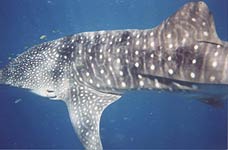
a) A-076 photographed in 1999 with dorsal fin intact
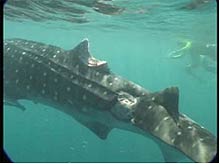
b) A-076 photographed in 2003 with dorsal fin
damaged from attack (© www.shepherdproject.org/sharks.jsp?shark=A-076)
|
| |
|
Ecotourism
- Australian ecotourism is well-managed through a shared approach between industry and government. At other locations around the world, ecotourism is developing and it is important that any activity is well-regulated to minimise any impacts on whale sharks.
- Whale sharks have shown a reaction to SCUBA bubbles, touching and flash photography and these activities are not permitted during whale shark ecotours in Australia.
Are Whale Sharks protected?
Whale sharks are protected in Australia, the Philippines, India, the Maldives, Honduras and some American waters. However, these are only a few of the 100 countries where whale sharks are known to visit. |
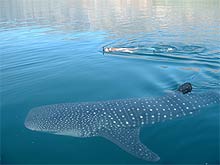
Whale sharks move slowly enabling ecotourists
to swim alongside (© www.ecocean.org) |
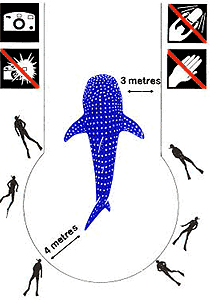 |
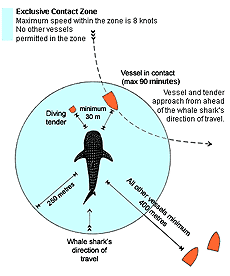 |
CALM / Industry management guidelines to minimise impacts on sharks from ecotourism activities
http://www.calm.wa.gov.au/tourism/whalesharks_swimming.html |
Alex Gaut ( MESA) adapted this information sheet for children (which is suitable for primary school students) from the information sheet compiled for the general public by © Brad Norman (ECOCEAN) [info@whaleshark.org]
This information sheet may be copied for educational purposes. For any other purpose please contact your State MESA representative: http://www.mesa.edu.au/council/contacts.asp
|
